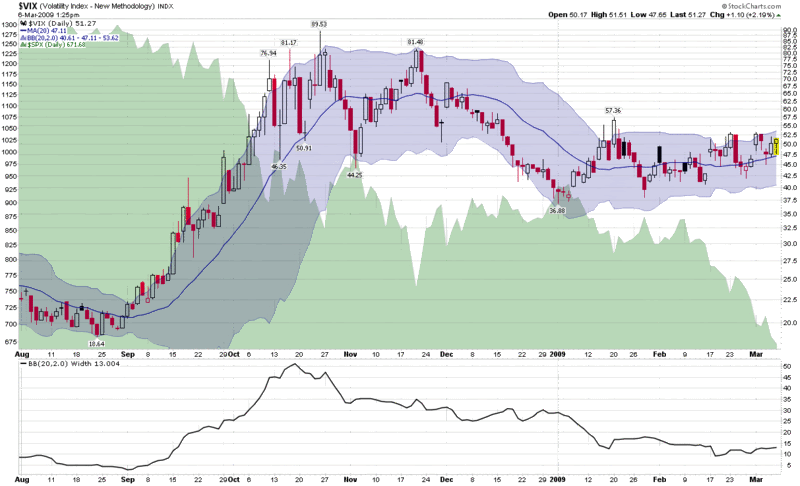Markets Continue to Fall, VIX Relatively Flat
When it comes to the VIX, lately the question on everyone’s mind is why the VIX has been relatively flat – and considerable lower than it was in October and November – while the markets have been making multi-year lows.
There are a couple of ways to look at this question.
First, consider historical volatility. From a strictly statistical perspective, 20 day historical volatility in the SPX peaked at 85 at the end of October and now sits at about 41, so in terms of actual recent volatility, a VIX of about half of the October-November highs seems consistent with recent market movements.
Of course the VIX reflects implied volatility, not historical volatility and implied volatility incorporates incremental changes in uncertainty and fear on top of recent historical volatility. At least this is an easy way to conceptualize some of the component parts of the VIX. The logical conclusion is that not only is the historical volatility component of the VIX dwindling, but so too are some of the uncertainty and fear aspects.
This is not to say that the current economic environment is lacking in fear and uncertainty. Still, there is a process of habituation and coping that has taken place over the course of the past six months. Michael Kahn, writing in Barron’s on Wednesday, calls this phenomenon Slow-Motion Capitulation, which will eventually lead to an “apathy bottom.” The idea is similar to what I proposed a day earlier as a “stealth bottom.”
While I think all of the above is important, I also think it overlooks the obvious. As I write this the S&P 500 index is 57.4% below its October 2007 high. In October and November, there were concerns that the SPX could fall several hundred points more. Well it has. Now a couple hundred additional points to the down side may still be in the cards, but it will be increasingly difficult for shorts to squeeze money out of already depressed equities. Also, as investors have slowly capitulated over the course of the past year or so, there are fewer and fewer holdouts left to panic – and many of those already have purchased put protection for their remaining long positions.
The chart below shows that death by 1000 cuts will not likely trigger a VIX spike. Regardless of what your directional outlook is for equities, this looks to be a good time to be selling options, particularly using vertical credit spreads.

[source: StockCharts]


6 comments:
potential market bottom in a week or two when vix goes more extreme. im expecting more capitulation.
VIX/VXV hovering around 1.08
Isnt that a buy signal (dare I use that b word)?
A close of 1.08 or above would be a buy signal. Actually Monday was a buy signal, with a close of 1.082.
I think the high continued implied volatility (without capitulation) reflects uncertainty on the part of option sellers.
It seems like a lot of big companies drank the derivatives kool-aid, and thus we're left wondering what F500 company is going to be brought to its knees next. On the upside, the right kind of government intervention could bring a huge pop.
So, I can imagine option sellers not being eager to sell cash secured puts to get long on unfairly battered companies - Warren Buffet is getting taken to the cleaners - while on the other hand selling uncovered calls has the potential to blow up in your face if there's a bear market rally, which the technicals indicate should happen any day now.
Meanwhile the guys who actually buy or sell stock are paralyzed, and the grind downward continues.
assuming a large part of the selling is due to individual and institutional liquidation (or moving more 80-20 equities to 20-80 equities), there wouldn't be large jumps in $VIX as a liquidating hedge fund won't need to hedge.
my $0.01.
Bill
Do you have a view on the fact that the Put Call ratio has put in some very low readings recently? It's 10 day MA has been very low relative to where the market is.
It suggests optimism. However, I read someone say that the low priced banking stock meant that buying a call on them was a cheap way to speculate and may be artificially increasing the number of puts. Do you think that's likely?
Douglas
Post a Comment